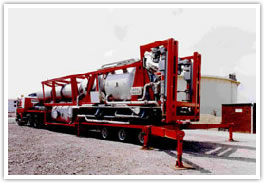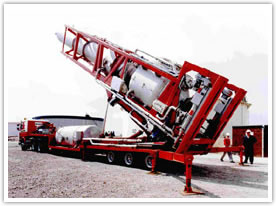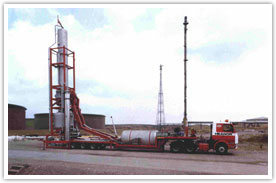Lagoon & Tank Bottom Processing Equipment
SEPS® System
The SEPS® three phase processing system combines established separation principles to recover clean and dry oil from hazardous hydrocarbon waste.
- Temperature enhanced hydrocyclonic effect
- Steam stripping Filtration and drying under vacuum
- Filtration and drying under vacuum

The SEPS® releases water suitable for discharge to drain, without further treatment and a dry, friable sediment containing no leachable hydrocarbons and suitable for landfill, road bases etc.
The SEPS® system can be used to process any mixture, which can be made “pumpable” and where there is an inherent gravitational difference between the components. For example, storage tank sludge, lagooned waste, oil spills on land or sea, solvent rich industrial waste, sewage sludge etc.
Safety features include an interlocked air operated valve system, explosion proofed power units, Zone 1 electrics and a totally enclosed gas condensation system.

Traditionally this type of equipment has involved the use of high speed rotating equipment, prone to mechanical breakdown and extremely hazardous in a gaseous environment.
The SEPS® system is available to purchase as a static or mobile unit to meet your daily waste processing needs.
Primary Separation Vessel
During processing this vessel is maintained as a predominately aqueous environment, in which the primary separation is effected. Pre-heated feed at up to 135°C is injected tangentially at up to two bar pressure into the pre-heated aqueous medium where the sediments, hydrocarbon and water are effectively separated. The hydrocarbon rich phase migrates to the centre of the vessels and being of lower specific gravity rises to the dewatering and progressive sedimentation column. The sediments, forced towards the shell of the separation vessel, fall under gravity into the filtration and drying chamber.
Filtration and sediment drying chamber
The sediments fall progressively from the primary separation vessel and consolidate in the filtration and drying chamber. Any hydrocarbons present in the initial feed which cannot be liquefied to rise into the dewatering and progressive sedimentation column will consolidate with the sediments for ultimate discharge. These hydrocarbons are primarily bitumastic and asphalmatic in nature and have therefore relatively high flash points. Sediment level is indicated by the extinction of the lower probe light. Once full, the filtration and drying chamber is isolated from the separation column. The aqueous phase is removed under vacuum through a filtration medium that retains fine particulate matter for ultimate discharge. The ostensibly oil free sediments are discharged to skips as a hot slurry which dries rapidly under ambient conditions to produce a friable solid for landfill, road ballast etc.
Dewatering and Progressive Sedimentation Column
Upon leaving the aqueous interface, the hydrocarbon rich phase is subjected to progressive dewatering and sedimentation over a number of perforated inverted cones. This effect is enhanced by subjecting the column to vacuum from the top which causes any entrained water to vaporise, and breaks the bond between retained sediments, leaving the recovered hydrocarbon extremely clean and dry. These particulate sediments, once released from the oil, fall under gravity to be consolidated in the filtration and drying chamber.

Vacuum Recovery Chamber
At the top of the column, above the recovered oil discharge point, is the vacuum recovery chamber, in this chamber the water released from the recovered oil phase exists as steam, creating an effectively inert atmosphere under full vacuum.
Any light ends present in the initial feed will be drawn through this chamber to be condensed and retained under vacuum in the vacuum receiving vessel.